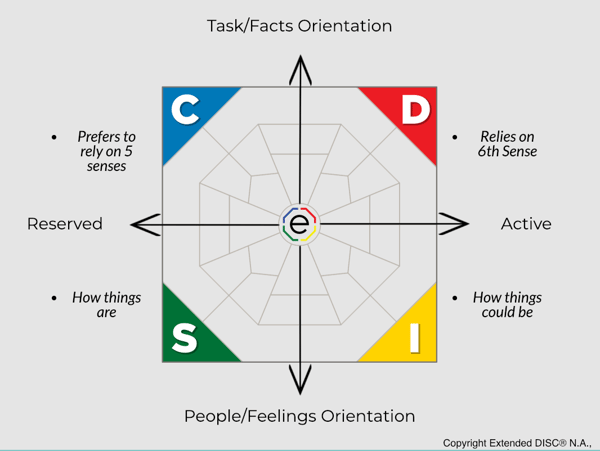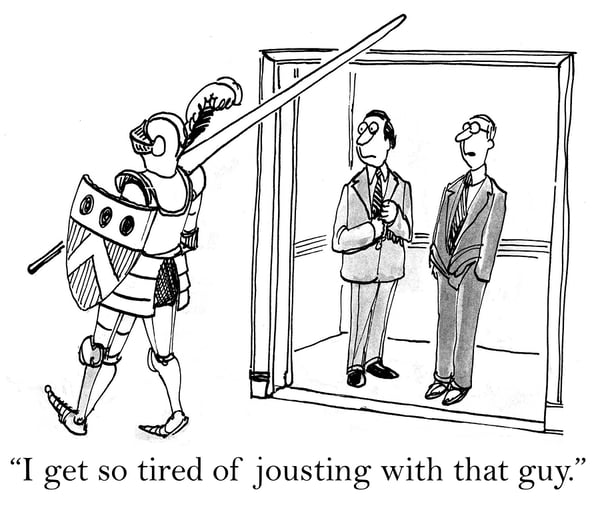Our interactions with our coworkers help determine our professional success. What happens when those interactions are not optimal?

80% of the people who fail at work do so for one reason: they do not relate well to other people.
Robert Bolton, author of People Skills
How you relate to your coworkers can mean the difference between looking forward to your work day (okay, that still might be a stretch) and completely dreading it. It can also mean the difference between professional success and failure. More often than not, frustration and misunderstanding are caused by the different styles of people.
4 steps to improving coworker interactions
A key to boosting your coworker interactions is understanding the 4 Steps to Effective Communication. It uses the DISC framework to improve your interactions and ultimately be more successful.
First off, we need to understand how our behavioral styles are similar and different. Next, we can use the Extended DISC Assessment to understand our natural style and how we are seen by others. Our blind spot is the difference between our self-perception and how we come across to others. For example, you may see yourself as quietly listening and processing information during your team's discussions, but your coworkers may see you as being non-participative or even disinterested. Your coworkers may not understand your intentions which can lead to misunderstanding.
 The next step is to identify the style of your coworkers. It takes practice to do it regularly, but you can become proficient over time. You can start by focusing on the coworkers you work closest with. What patterns of behaviors do you observe in them? Are they more reserved or outgoing? Are they more individualistic or a team player? Do they prefer to work alone or do they need someone to bounce ideas off of? Do they rush into decisions without worrying about facts and details or are they slower and more methodical in making decisions?
The next step is to identify the style of your coworkers. It takes practice to do it regularly, but you can become proficient over time. You can start by focusing on the coworkers you work closest with. What patterns of behaviors do you observe in them? Are they more reserved or outgoing? Are they more individualistic or a team player? Do they prefer to work alone or do they need someone to bounce ideas off of? Do they rush into decisions without worrying about facts and details or are they slower and more methodical in making decisions?
Once you've identified their preferred patterns of behaviors, then try identifying their primary style. The goal is not to box them into a style; but instead, gather more information on how to interact better with them.
Putting the 4 steps into practice
Next, is the final and most important step. Now that you've identified their primary style, what would you do differently the next time you interact with them? Try to keep it simple, but be as specific as possible in your adjustments. For example, instead of naturally rushing into your D-style coworker's office with your latest and greatest idea, take a moment to remember their style. You may need to consciously remind yourself focus on the core tasks and the end goal instead of spending a lot of time on details or chit chat. You are more likely to engage your D-style coworker and walk away from the interaction more successfully if you make those sorts of adjustments. Who knows, they may even notice your efforts and make reciprocal efforts to adjust when interacting with you?
Here's another example. You've got some changes and edits to your project timeline because it needs to be sped up to meet the deadline. Stop right there! If you're about to walk into your C-style coworker's office, take a few seconds to make a conscious adjustment to ensure sure you have a more successful interaction. It could be as simple as sending an email highlighting the edits, justifying them, and requesting a meeting. You might have to cool your heels a bit, but your brief adjustments can mean the difference between failure and success.
DISC tools to help you improve coworker interactions
How often do we have the chance to openly discuss our communication styles and our dynamics? I'm assuming not often or never. DISC can help by creating an opportunity to identify our unique comfort areas and explain how each one of us prefer to do things in a non-judgmental setting.
If you're someone who prefers to communicate by emails or to work alone with structure and routine, but you coworker likes fly by the seat of his/her pants or prefers to meet face-to-face, then your awareness and ability to adjust can mitigate the interaction more effectively. There will be times in your interactions you'll need to push yourself outside your comfort zone. Remember, we cannot control our coworkers or expect them to make adjustments. We only have control over ourselves and the adjustments we can make.
Be mindful of your nonverbal cues. Your body language conveys part of the message. Coworkers observe tone of voice, eye contact, and even how you manage your personal space. You can try practicing or being more consciously aware of these the next time you interact with your challenging coworker.
Final thoughts

Another way to understand your difficult coworker is to reframe your perspective. You and your coworker will tend to see things differently based on your styles. Try viewing behaviors and actions as neutral; it is our own perception of the action that gives it meaning and value. Does your coworker's perspective of issues and things differ from yours? If so, how are they likely to perceive things? What value does your coworker bring to your daily work life? Do they make your life easier by doing things you may not like doing?
If you openly share your styles, you are more likely to accept each other's differences, find common ground, and best of all, make adjustments. Remember, you and your coworkers need to own your styles. There will be times both of you only acknowledge your differences and move on. You don't have to become friends or even get along all the time, but you do have to be productive in your interactions so you can be successful in your jobs. It starts with you.
You can leave your organization to avoid the person who makes you crazy, but he/she will be waiting for you at the next company in a different body.
Shari Harley, Business Communication Author
